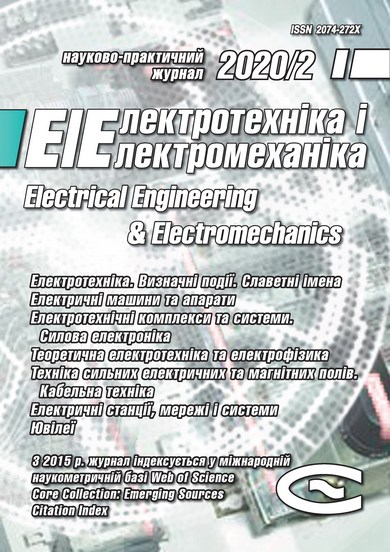COMPARATIVE ANALYSIS OF TWO HIGH-SPEED SINGLE-PHASE ELECTRICAL MACHINES WITH PERMANENT MAGNETS ON THE STATOR
DOI:
https://doi.org/10.20998/2074-272X.2020.2.03Keywords:
high speed machines, hybrid switched reluctance machine, flux reversal electrical machine, permanent magnet machine, single-phase electrical machine, special electrical machineAbstract
Purpose. Single-phase machines with permanent magnets on the rotor are widely used in a variety of applications of a low rated power. When these machines are applied in high-speed applications, a retaining ring on the rotor core must be often used. However, it makes the assembly more complex and the high-speed machines become more expensive. On the other hand, machines with magnets on the stator still can be a valuable alternative due to their simple and reliable rotor design. In this paper the comparative study of performances of two single-phase electrical machines with magnets on the stator (flux reversal electrical machine and hybrid switched reluctance machine) is presented. The following performances have been compared: efficiency, weight, active materials cost, value of rated current of switches of the frequency converter. Methodology. Calculation of electrical machines performances using solving two-dimension boundary magnetostatics problems. Results. The theoretical comparison of the flux reversal electrical machine and the hybrid switched reluctance machine has been carried out; the comparison on specific torque and efficiency of the two aforementioned machines have been obtained. The flux reversal machine has a significantly higher efficiency and a fewer weight. In addition, it has a lower value of rated current. On the contrary, the cost of active materials of the hybrid switched reluctance one is much less. Originality. The presented results can assist in selecting the best design alternative of electrical machines in the following applications: electrical blowers, household appliances, fans, pumps and compressors of a low rated power etc. Practical value. The comparisons results of the flux reversal electrical machine and the hybrid switched reluctance machine has been obtained for the first time.References
Bentouati S., Zhu Z., Howe D. Permanent magnet brushless DC motors for consumer products. Proceedings of the 9th International Conference on Electrical Machines and Drives (Conf. Publ. No. 468), pp. 118-122,Canterbury,UK, 1-3 September 1999.
Jeong K., Ahn J. Design and characteristics analysis of a novel single-phase hybrid SRM for blender application. Journal of Electrical Engineering and Technology, 2018, vol. 13, no. 5, pp. 1996-2003. doi: 10.5370/JEET.2018.13.5.1996.
Torok V., Loreth K. The world’s simplest motor for variable speed control? The Cyrano motor, a PM-biased SR-motor of high torque density. Proceedings of the 1993 5th European Conference on Power Electronics and Applications, Brighton, UK, 13-16 Sept. 1993.
Deodhar R.P., Andersson S., Boldea I., Miller T.J.E. The flux-reversal machine: a new brushless doubly-salient permanent-magnet machine. IEEE Transactions on Industry Applications, 1997, vol. 33, no. 4, pp. 925-934. doi: 10.1109/28.605734.
Dmitrievskii V.A., Prakht V.A. Odnofaznaia elektricheskaia mashina [Single-phase electrical machine]. PatentRussian Federation, no. 2524144, 2014. (Rus).
Dmitrievskii V., Prakht V., Pozdeev A., Klimarev V., Mikhalitsyn A. Angular grinder with new flux reversal motor. Proceedings of the 18th International Conference on Electrical Machines and Systems (ICEMS), pp. 1366-1371,Pattaya,Thailand, 25-28 October 2015.
Dmitrievskii V.A., Prakht V.A. Mathematical simulation of a high-speed single-phase machine with alternating current direction. Russian Electrical Engineering, 2016, vol. 87, no. 6, pp. 327-332. doi: 10.3103/s1068371216060043.
Dmitrievskii V., Prakht V., Kazakbaev V., Sarapulov S. Steady-state model of a single-phase flux reversal motor. Proceedings of 58th International Scientific Conference on Power and Electrical Engineering of Riga Technical University (RTUCON 2017), pp. 1-5, Riga, Latvia, 12-13 October 2017.
Dmitrievskii V., Prakht V., Kazakbaev V., Sarapulov S. Optimal design of a high-speed single-phase flux reversal motor for vacuum cleaners. Energies, 2018, vol. 11, no. 12, p. 3334. doi: 10.3390/en11123334.
Goss J., Popescu M., Staton D. A comparison of an interior permanent magnet and copper rotor induction motor in a hybrid electric vehicle application. Electric Machines & Drives Conference (IEMDC), 2013 IEEE International, pp. 220-225, Chicago, IL, USA, 12-15 May 2013. doi: 10.1109/iemdc.2013.6556256.
Rahman T., Mohammadi M.H., Humphries K., Lowther D.A. Comparison of fractional-slot concentrated winding and PM-assisted synchronous reluctance motors for class IV electric vehicles. Proceedings of IEEE Int. Electrical Machines and Drives Conf. (IEMDC 2017), Miami, pp. 1-7, USA, May 2017. doi: 10.1109/iemdc.2017.8002173.
Calvo E., Potoradi D. Synchronous reluctance motors with and without permanent magnets for high performance low cost electrical drives. Proceedings of 5th International Electric Drives Production Conference (EDPC 2015), pp. 1-7, Nuremberg, Germany, 15-16 September 2015. doi: 10.1109/edpc.2015.7323220.
ChenYang NdFeB Magnets. Price List of Standard Block Magnets. Available at: http://www.ndfebmagnets.de/CY-PriceList-NdFeB-Block.pdf (accessed 05 July 2019).
IBSMagnet. Hard ferrite magnets. Available at: https://ibsmagnet.com/products/dauermagnete/hartferrit.php (accessed 05 July 2019).
Lee W., Kim J.H., Choi W., Sarlioglu B. Torque Ripple Minimization Control Technique of High-Speed Single-Phase Brushless DC Motor for Electric Turbocharger. IEEE Transactions on Vehicular Technology, 2018, vol. 67, no. 11, pp. 10357-10365. doi: 10.1109/tvt.2018.2866779.
Downloads
Published
How to Cite
Issue
Section
License
Copyright (c) 2020 V. A. Prakht, V. A. Dmitrievskii, V. M. Kazakbaev, S. Kh. Oshurbekov

This work is licensed under a Creative Commons Attribution-NonCommercial 4.0 International License.
Authors who publish with this journal agree to the following terms:
1. Authors retain copyright and grant the journal right of first publication with the work simultaneously licensed under a Creative Commons Attribution License that allows others to share the work with an acknowledgement of the work's authorship and initial publication in this journal.
2. Authors are able to enter into separate, additional contractual arrangements for the non-exclusive distribution of the journal's published version of the work (e.g., post it to an institutional repository or publish it in a book), with an acknowledgement of its initial publication in this journal.
3. Authors are permitted and encouraged to post their work online (e.g., in institutional repositories or on their website) prior to and during the submission process, as it can lead to productive exchanges, as well as earlier and greater citation of published work.





